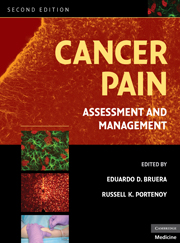Book contents
- Frontmatter
- Contents
- Contributors
- Preface
- SECTION I MECHANISMS AND EPIDEMIOLOGY
- SECTION II EPIDEMIOLOGY AND SYNDROMES
- SECTION III ASSESSMENT
- SECTION IV PHARMACOLOGICAL TREATMENT
- 9 Pharmacology of analgesia: basic principles
- 10 Pharmacogenetic considerations in the treatment of cancer pain
- 11 Pharmacology of opioid analgesia: clinical principles
- 12 Opioid side effects and management
- 13 Antipyretic analgesics
- 14 Adjuvant analgesic drugs
- 15 Neuraxial analgesia
- SECTION V OTHER INTERVENTIONAL STRATEGIES
- SECTION VI REHABILITATION AND PSYCHOLOGICAL INTERVENTIONS
- SECTION VII THE ROLE OF ANTINEOPLASTIC THERAPIES IN PAIN CONTROL
- SECTION VIII PAIN IN SPECIAL POPULATIONS
- SECTION IX DIFFICULT PAIN PROBLEMS
- SECTION X SYSTEMS OF CARE
- Index
- Plate section
- References
12 - Opioid side effects and management
from SECTION IV - PHARMACOLOGICAL TREATMENT
Published online by Cambridge University Press: 06 July 2010
- Frontmatter
- Contents
- Contributors
- Preface
- SECTION I MECHANISMS AND EPIDEMIOLOGY
- SECTION II EPIDEMIOLOGY AND SYNDROMES
- SECTION III ASSESSMENT
- SECTION IV PHARMACOLOGICAL TREATMENT
- 9 Pharmacology of analgesia: basic principles
- 10 Pharmacogenetic considerations in the treatment of cancer pain
- 11 Pharmacology of opioid analgesia: clinical principles
- 12 Opioid side effects and management
- 13 Antipyretic analgesics
- 14 Adjuvant analgesic drugs
- 15 Neuraxial analgesia
- SECTION V OTHER INTERVENTIONAL STRATEGIES
- SECTION VI REHABILITATION AND PSYCHOLOGICAL INTERVENTIONS
- SECTION VII THE ROLE OF ANTINEOPLASTIC THERAPIES IN PAIN CONTROL
- SECTION VIII PAIN IN SPECIAL POPULATIONS
- SECTION IX DIFFICULT PAIN PROBLEMS
- SECTION X SYSTEMS OF CARE
- Index
- Plate section
- References
Summary
Introduction
The majority of cancer patients (approximately 80%) develop pain before they die. Pain in cancer patients is often underdiagnosed, and inadequate treatment with opioid analgesics is well documented. Many factors influence pain management in this patient group. Inappropriate and suboptimal education of physicians and other health care professionals has been identified as the major barrier to adequate opiate use. In developing countries, a further issue is reduced availability of opioids due to financial limitations and government regulations.
As a result of a major educational effort by a number of organizations, including the World Health Organization, the International Association for the Study of Pain, and the American Society of Clinical Oncology, opioid use has improved very significantly in developed countries during the past two decades. The results of such efforts have been quite variable. However, in many regions of the world, progress has been made, with opioids being used in higher doses and at earlier stages in palliative care. Cancer patients, who now have earlier exposure to opioids and generally have treatment with higher dosages, are better managed than in the past. This highly desirable increase in the use of opioids, combined with increased vigilance, has resulted in increased detection of several side effects, most notably neurotoxicity. With this increase in opioid use and the improvement in identification of adverse effects, management strategies for dealing with these unwanted effects have been developed and augmented.
- Type
- Chapter
- Information
- Cancer PainAssessment and Management, pp. 230 - 254Publisher: Cambridge University PressPrint publication year: 2009



